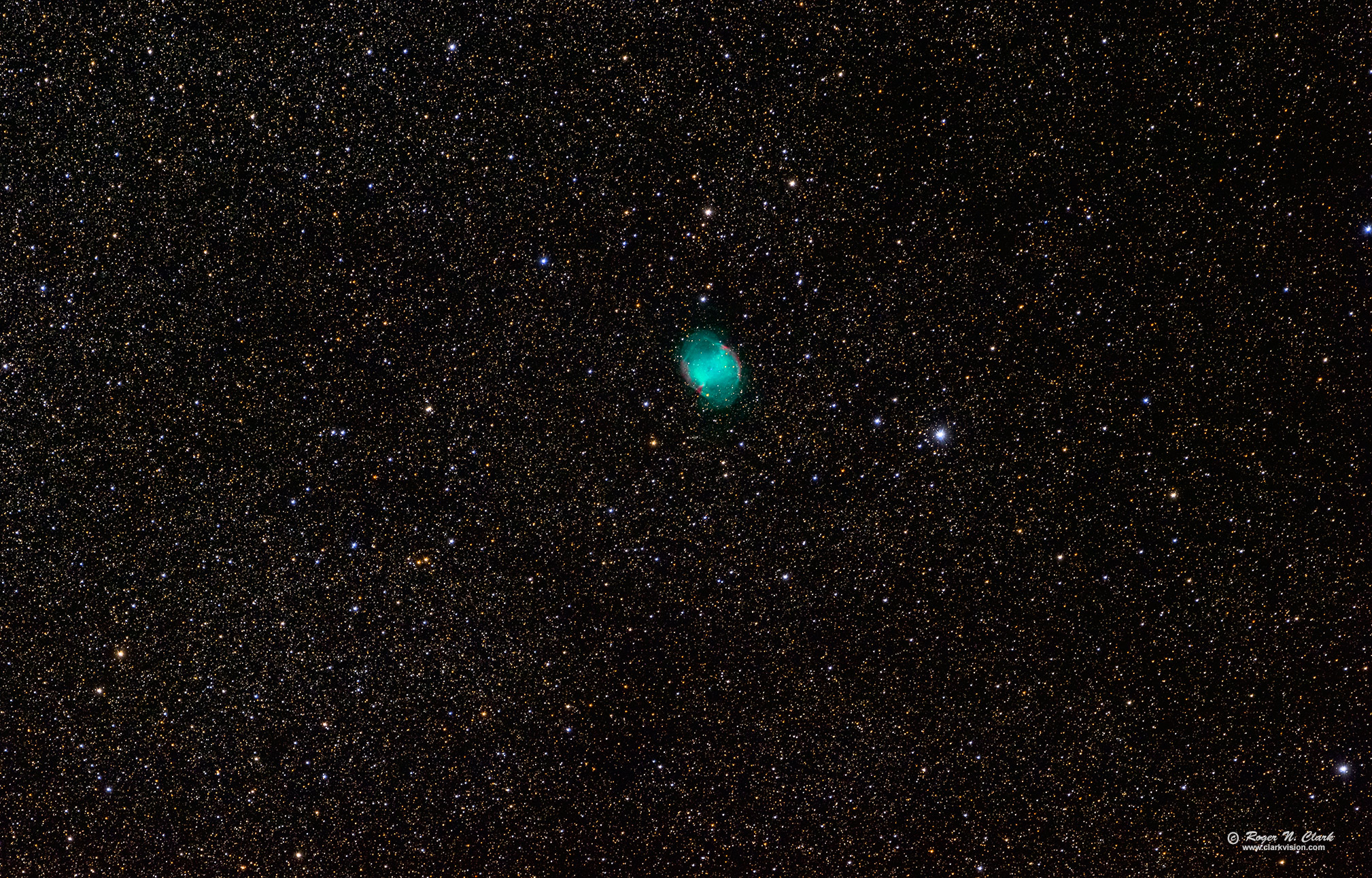| Home | Galleries | Articles | Reviews | Best Gear | New | About | Contact | Gallery Index |
Next |

| Home | Galleries | Articles | Reviews | Best Gear | New | About | Contact | Gallery Index |
Next |

The Dumbbell Nebula, Messier 27, is a showpiece in small telescopes. The teal color of M27 is due to oxygen emission; the red is from hydrogen emission. M27 is quite bright and can be seen even in cities with moderate light pollution. The brightness enables reasonable images to be made with short exposure times. Most of the detail in this image can be seen with telescopes of about 12-inches (30 cm) aperture from dark sites, though the colors are more pastel teal. Note if you have a stock digital camera and the color comes out blue, it is an indication of a poor (or no) color matrix correction.
The image is a good illustration of the mix of colors of stars in our galaxy: a few blue stars more white stars and most stars are yellow, orange and red.
M27 is younger than 15,000 years has a diameter of about 2 light years, and is expanding at a rate of 31 km/second.
Technical. This image was obtained with a stock Canon EOS 90D DSLR Camera and Canon 500 mm f/4 L IS lens (Newer model: Canon EF 500mm f/4L IS II USM Lens). Total exposure time was 19.5 minutes (thirteen 90-second exposures) at ISO 1600. This is a natural color image. Post processing: raw conversion with Photoshop ACR (normally I would use rawtherapee, but the color matrix correction in rawtherapee did not do well with the emission), stacking with deep sky stacker, Stretched with rnc-color-stretch, and final adjustments in photoshop. No darks, no flats, no bias frames (flat field is in the ACR lens profile and corrected during raw conversion). The exposures were tracked on a Losmandy G11 equatorial mount with an autoguider. Mean RMS tracking accuracy was around 0.5 arc-second. This is the full frame image at 1/3 resolution (3.96 arc-second / pixel). The image was made at a dark site in the mountains of Colorado at an elevation of about 7600 feet.
This is a natural color image.
The Exposure Factors, CEF, CEFA are measures of the relative amounts of light received from a subject. It can be used to fairly compare wildly different lens/telescope apertures and exposure times. For this image on the sky:
Modern digital cameras like the Canon 90D include on sensor dark current suppression technology and low fixed pattern noise at ISOs around 800 and higher, making no need for dark frame subtraction. Modern raw converters correct for light fall-off and also correct for hot/dead/stuck pixels. This makes processing low light images easy: simply align and average.
Also see Astrophotography Image Processing Basic Work Flow.
To learn how to obtain stunning images like this, please visit my Extensive Articles on Photography .
Keywords to this image = astrophoto-1 nebula Messier night low-light digital_astro canon_90d
Image ID: m27-500mm-90d-rnclark-c09.04.2021-IMG_1053-1066-av13.e-0.33xs.jpg
| Home | Galleries | Articles | Reviews | Best Gear | Science | New | About | Contact |
Last updated November 08, 2025